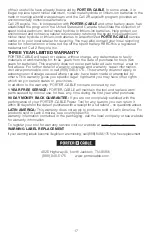
4
•
Do not use this nailer for fastening electrical cables.
It is not designed for
electric cable installation and may damage the insulation of electric cables thereby
causing electric shock or fire hazards.
ADDITIONAL NAILER SAFETY WARNINGS
WARNING:
When using any nailer, all safety precautions, as outlined below,
should be followed to avoid the risk of death or serious injury. Read and understand all
instructions before operating the tool.
• Hold tool by insulated gripping surfaces when performing an operation where the
cutting tool may contact hidden wiring. Contact with a “live” wire will make exposed
metal parts of the tool “live” and shock the operator.
•
Actuating tool may result in flying debris, collation material, or dust which
could harm operator’s eyes.
Operator and others in work area MUST wear safety
glasses with side shields. These safety glasses must conform to ANSI Z87.1
requirements (approved glasses have “Z87” printed or stamped
on them. It is the employer’s responsibility to enforce the use of
eye protection equipment by the tool operator and other people in
the work area. (Fig. 1)
• Always wear appropriate personal hearing and other protection
during use. Under some conditions and duration of use, noise
from this product may contribute to hearing loss. (Fig. 1)
•
Disconnect battery pack from the tool when not in use.
Always remove battery pack and remove fasteners from magazine before
leaving the area or passing the tool to another operator.
Do not carry tool to
another work area in which changing location involves the use of scaffoldings,
stairs, ladders, and the like, with battery pack connected. Do not make
adjustments, perform maintenance or clear jammed fasteners while battery is in
place.
• Do not remove, tamper with, or otherwise cause the tool, trigger, trigger lock-off, or
contact trip
to become inoperable.
Do not tape or tie trigger or contact trip in the
ON position. Do not remove spring from contact trip. Make daily inspections for free
movement of trigger and contact trip. Uncontrolled discharge could result.
•
Inspect tool before use.
Do not operate a tool if any portion of the tool, trigger,
trigger lock-off, or contact trip is inoperable, disconnected, altered, or not working
properly. Damaged parts or missing parts should be repaired or replaced before
use. Refer to
Maintenance
.
• Do not alter or modify the tool in any way.
• Always assume that the tool contains fasteners.
• Do not point the tool at co-workers or yourself at any time.
No horseplay! Work safe! Respect the tool as a working
implement. (Fig. 2)
•
Keep bystanders, children, and visitors away while
operating a power tool.
Distractions can cause you to lose
control. When tool is not in use, it should be locked in a
safe place, out of the reach of children.
• Do not carry the tool from place to place holding the
trigger. Accidental discharge could result.
•
Always use trigger lock-off when tool is not in immediate
use. Using the
trigger lock-off
will prevent accidental
discharge.
•
Do not overreach. Maintain proper footing and balance
at all times.
Loss of balance may cause personal injury.
(Fig. 3)
FIG. 1
FIG. 2
FIG. 3
Содержание PCC792
Страница 55: ...55...
Страница 56: ...56 Catalog Numbers PCC792 Form 90631744 rev01 January 2016 Printed in China...





































